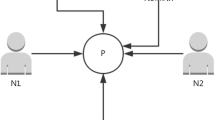Abstract
In this paper, we realize Shamir’s no-key protocol via quantum computation of Boolean functions and a private quantum channel. The proposed quantum no-key protocol has three rounds and provides mutual data origin authentication. Random Boolean functions are used to create entanglement and guarantee that any adversary without keys cannot pass the authentication. Thus, our protocol can resist the man-in-the-middle attack. A security analysis has shown that pieces of ciphertexts of the three rounds are completely mixed state. This property ensures no adversary can get any information about the sent message or authentication keys. Therefore, our protocol is unconditionally secure and its authentication keys can be reused.
Similar content being viewed by others
References
Menezes G J, van Oorschot P C, Vanstone S A. Handbook of Applied Cryptography. Boca Raton: Crc Press, 1997
Yang L, Wu L A. Transmit classical and quantum information secretly. 2002, arXiv: quant-ph/0203089
Yang L, Wu L A, Liu S H. Quantum three-pass cryptography protocol. In: Proceedings of SPIE 2002 Quantum Optics in Computing and Communications, SPIE, 2009. 4917: 107–112
Kanamori Y, Yoo S M, Mohammad A S. A quantum no-key protocol for secure data communication. In: Proceedings of Proc 43rd Annual Southeast Regional Conference. New York: ACM Press, 2005. 2: 92–93
Kak S. A three stage quantum cryptography protocol. Found Phys Lett, 2006, 19: 293–296
Kye W H, Kim C M, Kim M S, et al. Quantum key distribution with blind polarization bases. Phys Rev Lett, 2005, 95: 040501
Yang L. Quantum no-key protocol for direct and secure transmission of quantum and classical messages. 2003, arXiv: quant-ph/0309200
Wu Y, Yang L. Practical quantum no-key protocol with identification. In: Proceedings of the 5th International Conference on Information Assurance and Security, Xi’an, 2009. 540–543
Yang L. Quantum no-key protocol for secure communication of classical message. 2013, arXiv: 1306.3388
Boykin P, Roychowdhury V. Optimal encryption of quantum bits. Phys Rev A, 2003, 67: 042317
Ambainis A, Mosca M, Tapp A, et al. Private quantum channels. In: Proceedings of the 41st Annual Symposium on Foundations of Computer Science. Redondo Beach: IEEE Computer Society Press, 2000. 547–553
Nayak A, Sen P. Invertible quantum operations and perfect encryption of quantum states. Quantum Inf Comput, 2007, 7: 103–110
Wu C, Yang L. Qubit-wise teleportation and its application in public-key secret communication. Sci China Inf Sci, 2017, 60: 032501
Bennett C H, Brassard G, Breidbart S. Quantum cryptography II: how to re-use a one-time pad safely even if P= NP. Natural Comput, 2014, 13: 453–458
Acknowledgements
This work was supported by National Natural Science Foundation of China (Grant No. 61672517), National Cryptography Development Fund (Grant No. MMJJ20170108), National Key Research and Development Program of China (Grant No. 2017YFB0802502), and Fundamental Theory and Cutting Edge Technology Research Program of Institute of Information Engineering, CAS (Grant No. Y7Z0301103).
Author information
Authors and Affiliations
Corresponding author
Rights and permissions
About this article
Cite this article
Yang, L., Wu, C. & Xie, H. Mutual authenticated quantum no-key encryption scheme over private quantum channel. Sci. China Inf. Sci. 61, 022502 (2018). https://doi.org/10.1007/s11432-017-9180-2
Received:
Revised:
Accepted:
Published:
DOI: https://doi.org/10.1007/s11432-017-9180-2




